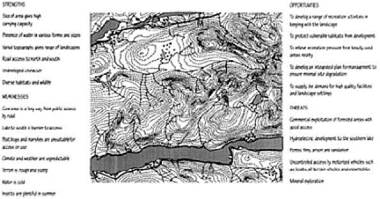There are various ways of refining the analytical process following from the basic inventory. One is to evaluate each character area or landscape zone. SWOT analysis provides a useful method.
SWOT stands for Strengths, Weaknesses, Opportunities and Threats. It is usual to divide the analysis of an area into those factors that are aspects of the site itself (strengths and weaknesses), and those that are affecting it from outside (opportunities and threats). There are two ways of completing an analysis. The first method is to list the factors under
|
A plan showing the possible range of opportunities for recreation in a landscape. Co-operation with neighbouring owners should always be considered. |
the four headings on a sheet of paper using a matrix format. This has the advantage of making it possible to see the relationships more easily, especially when factors can be both strengths and weaknesses at the same time. The second method is to identify the factors and record them on a map of the area. This helps to locate these factors and the way in which they are spatially related. It is of course possible to use both methods.
The advantage of a SWOT analysis is that it is quick, yet produces useful results and arranges them in a way that is of immediate use. The aim in design and management is to build on the strengths, minimize the weaknesses, take up as many of the opportunities as possible and avoid the threats. A useful method of initiating an analysis is to ‘brainstorm’ the issues: once a basic knowledge of the area has been gained from site visits, consider these, perhaps with other people or a project team, and classify all the issues into the various categories as they emerge from the discussion. Then sift them for importance and assess the implications of each for design and management.
If the area is used already and has some facilities, then the SWOT analysis can be used to appraise these so that they can be redesigned if necessary and improved to meet any new circumstances.
The SWOT analysis can be very helpful in developing the brief for the designer on the range of issues that need to be solved in order to achieve the objectives of a project. The
designer is then able to develop creative solutions in design and management terms that best fit the objectives and the requirements to sustain the characteristics of the landscape.
|
A plan showing how the landscape has been appraised using a SWOT analysis. |





